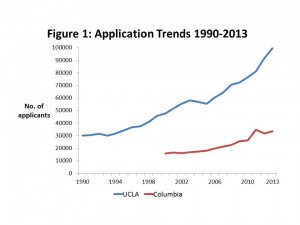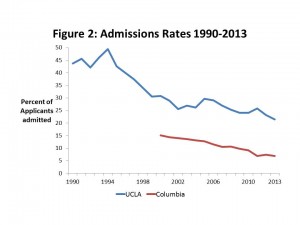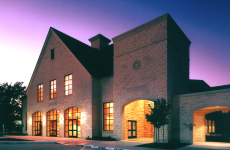Imagine if applying to college worked like a 50-50 raffle. You pay your application fee, get a ticket and watch the admissions officer at Really Elite Fancy Pants University pull numbers out of a hat to determine who gets a spot in the entering freshman class.
It seems unfair, right? So why would multiple commentators (see here, here and here) make the case for starting lotteries among elite universities to determine which applicants get in?
Because in many ways, admissions at elite universities are already mirror a lottery process, without the efficiency, and possibly without the fairness.
Applications to elite universities in the United States have exploded over the past two decades. Figure 1 shows the number of applications coming into UCLA, an elite public institution, since 1990; and Columbia University, an elite private institution, since 2000. UCLA’s applications have more than tripled – from about 29,000 to 99,000 between 1990 and 2013. Columbia’s applications have doubled since 2000, from about 16,000 to more than 33,000.
The corresponding acceptance rates have shrunk. As Figure 2 shows, UCLA’s acceptance rate was 43.7 percent in 1990, and has declined to 21.5 percent for the entering class of 2013. Columbia’s rates show a steep decline as well, shriveling from 15.2 percent for the entering class of 2000 to 6.8 percent in 2013.
Only part of the equation is that there is a larger total pool of qualified applicants. The other part of the increase is due to highly qualified high-school students applying to many more top-tier schools than to which they used to apply. Driven in part by the accessibility provided by the Common Application, a student who might have applied to three or four schools in the early 1990s now might apply to seven or eight –29 percent of students applied to seven or more colleges in 2012, in comparison to 2000 when only 12 percent of students applied to that many schools.
However, the influx of applications at top schools still means that progressively larger portions of qualified applicants are getting rejected at a given school, though it’s likely that they will get into at least one selective school. Seton Hall University Assistant Professor of Education Robert Kelchen noted recently at the Washington Monthly that Stanford University rejected 69 percent of its applicants for the class of 2013 who had a perfect score on the SAT, a statistic that suggests that a great number of those rejected would have been perfectly capable of succeeding at Stanford.
At some level, the process of selection is random. Admission officers, each of whom have to sort through hundreds of applications, have to make quick determinations of whether to accept, reject or waitlist a group of highly qualified applicants. Sorting through the “embarrassment of riches” is going to be a somewhat random process even with clear rubrics and lots of time – but will become even more so in the rush. Admissions Officers aren’t entirely arbitrary. At some institutions they do selectively shape the class to encourage some sorts of admissions – most schools give preferences to the children of wealthy alumni, and try to increase representation of underrepresented minorities (although this latter practice is now banned or limited at public universities in many states, like California or Michigan and Texas).
Why not simply automate the lottery process? The admissions staff can simply loosely rate a student as “qualified” or “unqualified,” then put all the qualified students in a lottery. Most elite schools have a large enough entering class that randomization wouldn’t distort admissions – Stanford’s incoming class of 1,700 and Columbia’s roughly 1,400 are similar to the sample size of large public opinion polls – so they should be representative of the underlying qualified pool of applicants. Lotteries can also ensure that applications truly need-blind, as well, since a random numbers generator does not take into account a family’s financial wealth.
Lotteries might hurt racial diversity somewhat at private schools that currently employ forms of affirmative action, which is a possible pitfall. However, the lottery would probably increase diversity at state institutions that currently aren’t allowed to overtly consider race in applications, by giving a truly equal chance for any applicant deemed “qualified” to get in. Note that this system does not answer broader questions of race and privilege in education, which start affecting children in preschool – or even before— and are exacerbated as the schooling process proceeds.
As Kelch notes, field research on this topic would be useful. He suggests having a university employ a lottery system for all students deemed qualified and compare the graduation results of those admitted with those who didn’t, as well as with results of the past class. For better control, I would suggest randomizing selection into the lottery. Half the qualified applicants should go through the traditional admissions process, while half should go through the lottery process. This controls for both time and university. After a few years of data-gathering (preferably replicated at several universities), we’d have a pretty good idea of how selecting incoming classes by lottery would affect student pools and outcomes at top schools.
My educated guess is it won’t have any measurable effect at all on academic achievement, though I suspect it would exacerbate the trend of applying to multiple schools, as students try to maximize their chances of getting in somewhere.
















Pingback: What drives college application increases?